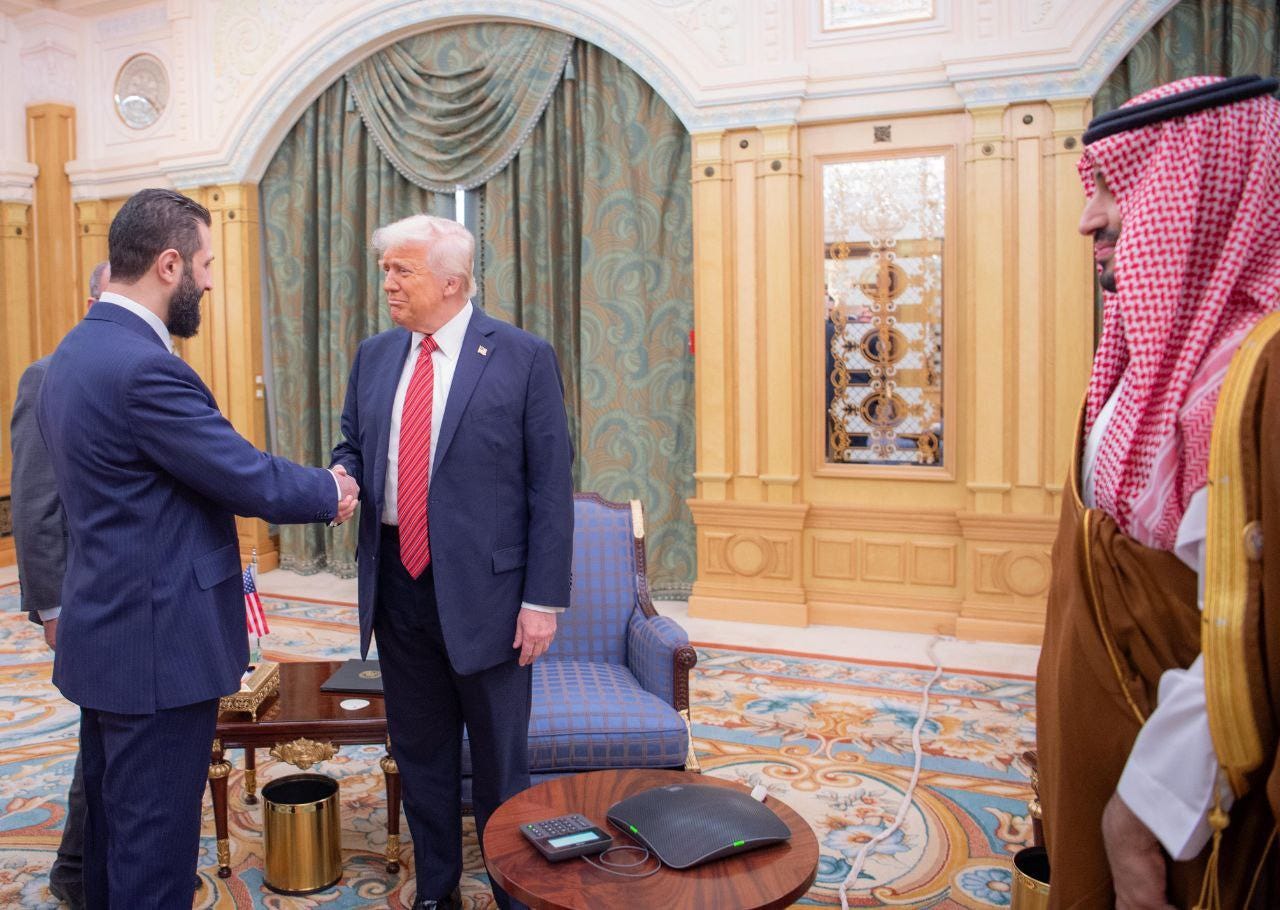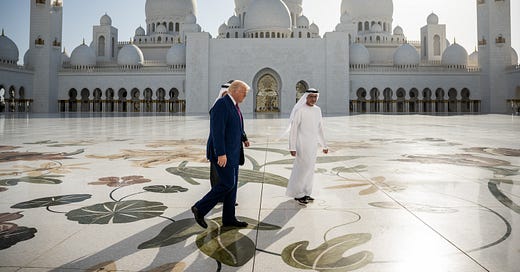Trump's Middle East tour
In his first international trip since returning to office, President Donald Trump's flashy Gulf tour was notable for who he did – and did not – meet.
In the days building up to President Donald Trump’s first international visit since returning to the White House, many were expecting the Gulf Arab countries that he was visiting – Saudi Arabia, Qatar and the United Arab Emirates – to pull out all of the stops to “whoo” the U.S. president to not only continuing his support for them, but to expand upon it.
On top of that, Trump was looking to get these Gulf countries to invest trillions of dollars into the United States, something that most observers were skeptical was possible, even if the countries made pledges.
Trump’s receptions in the three countries were exactly as expected: flashy, big and, above all else, expensive.
Upon arriving in Saudi Arabia on the first leg of his Middle East tour on May 13, Air Force One was given an escort by Saudi Arabia’s air force and, after touching down, Crown Prince Mohammad bin Salman, the defacto leader of the kingdom, personally met him and walked him own the purple carpet laid out for the American president.
But, outside of attempts to impress Trump to get on his good side, the president’s visits stood out after he not only announced that he was meeting Syria’s new president, Ahmad al-Sharaa, but that the United States was going to lift all sanctions on Syria.

A massive policy shift
For decades now, the U.S. has refused to lift sanctions on Syria until saw significant changes in the country’s policy when it came to “supporting terrorism” and violations of human rights. This only accelerated after the start of the Arab Spring when countless Syrians went to the streets demanding an end to the Assad regime, only to be arrested, tortured and killed by Syria’s dreaded security forces.
The Caesar Act targeted individuals and entities affiliated with the regime and automatically put sanctions on them in the hopes that targeting the regime’s money, then it would force then-President Bashar al-Assad to reform. This never happened.
Even after the unexpected downfall of the regime on Dec. 8, 2024, the Biden administration refused to lift sanctions until the country’s new rulers proved that they would be different from the previous regime.
The Trump administration kept with this policy, especially after thousands of Alawites were massacred in February and March and dozens of Druze were killed in early May by armed groups affiliated with the new Syrian government.
Then Trump flew to Saudi Arabia, where it was speculated that he would meet with Sharaa. When it was finally announced, no one could have guessed that Trump would then say that the U.S. was going to lift all sanctions on Syria because they “served their purpose” and to “give them a chance at greatness.”
Sharaa also apparently left a lasting impression on Trump when they met because, while speaking with the White House press pool, Trump said that Sharaa was a “real leader” and “pretty amazing.” When asked how the meeting went, Trump said it was “great” and that Sharaa was a “young, attractive guy. Tough guy. Strong past. Very strong past. Fighter.”
This whirlwind meeting was immediately celebrated in Syria, where people set off fireworks as the Syrian people hoped that these developments would lead to the rebuilding of the country after 14 years of war and a return to its past glory.
During the Syrian civil war, the value of the Syrian Lira to the dollar went from LS 47 before the war to LS 25,000 during the December rebel offensive. Since the fall of the Assad regime and Trump’s announcement, the Syrian Lira has appreciated to around LS 10,000 to $1.
Now that sanctions are being lifted and countries and companies can begin investing in the country, there is genuine optimism that the situation in the country could improve.
While Syrians are celebrating the shift in U.S. policy toward their country and are enjoying significantly more freedoms than they did under Assad, the targeting of Alawites and clashes with Druze militias, along with Sharaa’s background as the leader of an Islamist group, have left many people skeptical about the future and to wait and see what happens before getting too comfortable.
Even as Trump’s surprise meeting with Sharaa made headlines and the American president continued his visit to the Middle East, many also noted the one country that Trump was not going to: Israel.

Snubbed
When the White House announced that Trump would be going to the Middle East for his first foreign trip, many assumed that Israel would be included on that list, especially as the U.S. has been trying to broker a new ceasefire in Gaza after Israel restarted its offensive on March 18 and cut off all aid into the enclave.
Instead, Israel was excluded and Trump never bothered to make a last-minute stop.
On top of that, the U.S. brokered a separate ceasefire with the Houthis in Yemen, even as the Houthis continue to launch missiles at Israel, and negotiated with Hamas to release the last living American hostage in Gaza, even as Hamas continues to hold around two dozen living Israeli hostages. Israel was not included in any of these discussions.
The reason?
According to U.S. Ambassador to Israel Mike Huckabee, “the United States isn’t required to get permission from Israel” to do these things.
Despite Israeli Prime Minister Benjamin Netanyahu calling Trump the “greatest friend that Israel has ever had in the White House” during a visit to the U.S. in February, that relationship has increasingly appeared strained since then with one Trump advisor telling the Washington Post that Trump’s treatment of Netanyahu was “one notch above” the tense White House meeting between the American president and Ukrainian President Volodymyr Zelensky.
So far, a new ceasefire in Gaza has failed to materialize with both Hamas and Israel refusing to compromise. Because of this, Israel’s offensive on Gaza has only intensified with this past week being one of the deadliest since Israel restarted its offensive.
Earlier in the week, Israel said it was going to intensify its offensive to destroy Hamas, seeking to “conquer” Gaza if a new deal was not struck by the time Trump returned to Washington.
“In the coming days, we will go in with full force to complete the operation,” Netanyahu said in a video released by his office. “Maybe Hamas will say, ‘Wait — we want to release 10 more [hostages].’ Fine, bring them. We’ll take them. And then we’ll go in. But there will be no situation where we stop the war.”
Trump, while at a roundtable in Qatar, finally commented on Gaza, stating that the U.S. would turn the enclave into a “freedom zone.” This idea was similar to a previous plan he mentioned during Netanyahu’s White House visit in which he suggested that the U.S. should take over Gaza so it could be turned into a “Riviera of the Middle East,” an idea immediately rejected by every country except Israel.
This new proposal by Trump is unlikely to gain any more traction than his last one.
Aid also remains cut off from Gaza, with Israel refusing to allow any supplies to enter the enclave. According to a report by the Integrated Food Security Phase Classification, 1 in 5 Gazans are starving and an Israeli aid plan in which limited aid would be distributed in Gaza under strict Israeli conditions would do little to alleviate the situation.
“We’re looking at Gaza, and we got to get that taken care of,” Trump said on Friday to a press pool. “A lot of people are starving.”
In the meantime, supplies are continuing to become increasingly scarce in Gaza and the Israeli offensive is killing dozens of Palestinians and displacing hundreds more in a given moment.
Trump may not be on the best of terms with Netanyahu, but he also appears to have little problem with the ongoing offensive and is more focused on other issues.
Trump is prone to making decisions on the spot that often surprise his staff, who were unprepared and unaware of what the president was going to say, so all of this could change in an instant.
His Middle East tour is over and he is back in the U.S. with his focus, when it comes to the region, primarily on reaching a nuclear deal with Iran and while Israel has not yet launched the large ground offensive that it said it would, that also does not mean it will not.




